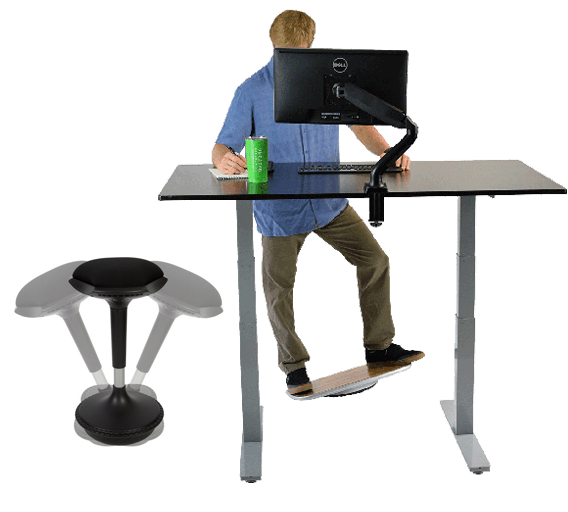An Adjustable Height Perch & Wobble Stool
Standing Desks Are Great, but Sometimes You Want to Sit
Standing at your desk can be great for your health and fitness. Like all workouts (even low-intensity ones), standing all day at the office can be fatiguing. In general, most people want to break up their day by sitting periodically—and sitting sometimes is generally ok!
Sit Higher During the Workday to Ease the Transition Back to Standing
C hairs, benches, stools, and even the floor are all fair game when you’re looking for a place to sit. What we’ve seen from almost a decade of experience creating ergonomic office furniture is that sitting in a traditional height chair can hinder the transition back to standing. A few reasons why sitting in a normal chair entices you to sit longer:
hairs, benches, stools, and even the floor are all fair game when you’re looking for a place to sit. What we’ve seen from almost a decade of experience creating ergonomic office furniture is that sitting in a traditional height chair can hinder the transition back to standing. A few reasons why sitting in a normal chair entices you to sit longer:
- Most office chairs, even the fancy ergonomic chairs, are designed to make sitting more comfortable.
- Sitting is easier on the body than standing. Sitting comfortably can create a mental block to moving all the way back up to standing.
- It takes more physical work to transition from a “normal” height chair to standing then from a taller stool. When sitting in a normal office chair, your knees are bent around 90 degrees, which is almost a full squat! It takes a lot of work to move from a full squat position up to standing. The work load is cut dramatically if you can sit higher—you’ll have a larger knee angle that’s much closer to standing’s approximate 180-degree position.
For these reasons, it’s best to sit on a higher chair or stool with your standing desk.
The Two Types of Taller Office Chairs
In general, taller office chairs come in two flavors:
- Drafting Chairs: originating from use with larger drafting tables that often required the designer to stand and move around their work, drafting chairs usually have a full back and a stationary base—kind of like putting a normal office chair on stilts. The key features to look for in a drafting chair are similar to those of a normal office chair. In general, the range of motion (especially with regards to the back rest) of drafting chairs will be less than normal height office chairs because the taller height of a drafting chair affords a larger fall risk.
- Active Stools: active stools are usually backless and have some form of instability that requires balancing and generally facilitate movement. Active stools come in a variety of flavors and are packed with distinct features.
Key Features to Look for in an Active Chair
-
 Balancing Function : active chairs with instability engage your core and back muscles as they force you to balance and control your movement. The best active stools give you the freedom to balance and sit still in a relaxed, stationary fashion so you can focus without stressing about falling.
Balancing Function : active chairs with instability engage your core and back muscles as they force you to balance and control your movement. The best active stools give you the freedom to balance and sit still in a relaxed, stationary fashion so you can focus without stressing about falling. - Swivel: swiveling seats give you the freedom to move and swiveling makes sitting more fun.
- Tip and Twist: controlled rocking helps you fidget away nervous energy and swaying lets you access a larger range of your desk from one position.
- Adjustable Height: The goal of most active stools is to sit higher so you can perch closer to standing height; thus making the transition back to standing easier and more likely to happen. Height adjustability is a key feature of the best active stool.
- Stable with the Freedom to Sit Stationary: Movement is great, but sometimes you just want to sit still and get some work done. The best active stools let you sit still without worrying about tipping over or falling. They are designed for stationary sitting and also give you the freedom to quickly initiate movement.

